A monthly e-newsletter from UMass Extension for landscapers, arborists, and other Green Industry professionals, including monthly tips for home gardeners.
To read individual sections of the message, click on the section headings below to expand the content.
To print this issue, either press CTRL/CMD + P or right click on the page and choose Print from the pop-up menu.
Hot Topics
Urban Trees and the Law: Reviewing the Basics
The topic of tree law continues to generate questions from the arboriculture/urban forestry community, and is quickly becoming a subject of increasing interest and relevance. Ongoing concern about damage to property and injury to individuals raises important questions regarding liability, ownership, and responsibility.
Courts often rely on two types of “laws” when issues are brought forward for litigation. As we know, legislative bodies draft statutes, or “written laws” that are regulated and enforced by agencies administered by an executive branch. In the United States, substantial latitude is provided to individual states in creating these statutes. Common law (or “case law”) arises from the judicial interpretation associated with a court’s authority to adjudicate these statutes. The body of common law may consist of a combination of legal theory, consideration of what other courts have ruled under similar scenarios (i.e. judicial precedent), and details of the circumstance at hand. While common law is most likely the type of law that will deal most with issues pertaining to trees, it is important to note that common law may be modified and that legislative law has primacy over common law. Here we will review and detail some frequently discussed topics regarding trees and the law, exploring areas that will include “negligence”, “trespass” and “nuisance.”
Negligence and Duty of Care
 Negligence may be defined as the unreasonable breaching of the duty of care that results in damage to a person or property. As one might suspect, landowners have different standards of care or “duty” associated with their property. With respect to trees, urban landowners probably own smaller properties with fewer trees than their rural counterparts. Thus, to avoid being potentially negligent, they should regularly inspect their land for the purpose of ensuring that the trees located on it do not pose excessive risk to neighbors, passers-by, and surrounding properties. If a tree were to fail and cause undue damage, a record of routine inspection may be produced in the event of a charge of negligence, claiming that the owner should have known the danger and failed to correct it. This standard of care incumbent on the landowner is referred to as the common-law negligence standard. Urban landowners may be held to a higher standard of care than a rural landowner who may own a larger tract of land, interact with fewer neighbors, and be less likely to note any sort of a defect on the numerous trees on their property. In essence, the duty to inspect a tree would likely increase as the risk of harm increases. While rural tree owners would not be altogether free from liability associated with their trees, it is commonly accepted that in trees in urban settings frequently pose a higher risk.
Negligence may be defined as the unreasonable breaching of the duty of care that results in damage to a person or property. As one might suspect, landowners have different standards of care or “duty” associated with their property. With respect to trees, urban landowners probably own smaller properties with fewer trees than their rural counterparts. Thus, to avoid being potentially negligent, they should regularly inspect their land for the purpose of ensuring that the trees located on it do not pose excessive risk to neighbors, passers-by, and surrounding properties. If a tree were to fail and cause undue damage, a record of routine inspection may be produced in the event of a charge of negligence, claiming that the owner should have known the danger and failed to correct it. This standard of care incumbent on the landowner is referred to as the common-law negligence standard. Urban landowners may be held to a higher standard of care than a rural landowner who may own a larger tract of land, interact with fewer neighbors, and be less likely to note any sort of a defect on the numerous trees on their property. In essence, the duty to inspect a tree would likely increase as the risk of harm increases. While rural tree owners would not be altogether free from liability associated with their trees, it is commonly accepted that in trees in urban settings frequently pose a higher risk.
For the professional arborist or urban forester, the duty of care would relate directly to the practices they employ relative to the care of trees on the properties of their clients or citizens. They would be expected to act as the prudent practitioner, giving advice and conducting their activities in a manner consistent with industry best practices.
Nuisance
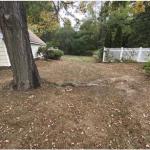 Nuisance refers to the unreasonable and substantial interference with the use or enjoyment of another’s property. Private nuisance occurs between and among individuals, and relative to trees, it may include the blocking of a view, overhanging branches, or impediment of light. A nuisance may be public when a threat or hindrance relates directly to the well-being of the greater community. In some states, a neighbor may take reasonable action to alleviate a nuisance situation (also known as the Massachusetts rule, that is considered consistent with the “self-help” theory), that may include pruning branches that overhang a walk or impede some portion of their property. Though this pruning may be done up to the property line, it is important to note that anyone employing this self-help rule must act responsibly so as to not willfully damage the tree, or detrimentally impact the overall health of the tree. It is also important to note that pruning should not occur beyond the property line, as this would constitute a trespass.
Nuisance refers to the unreasonable and substantial interference with the use or enjoyment of another’s property. Private nuisance occurs between and among individuals, and relative to trees, it may include the blocking of a view, overhanging branches, or impediment of light. A nuisance may be public when a threat or hindrance relates directly to the well-being of the greater community. In some states, a neighbor may take reasonable action to alleviate a nuisance situation (also known as the Massachusetts rule, that is considered consistent with the “self-help” theory), that may include pruning branches that overhang a walk or impede some portion of their property. Though this pruning may be done up to the property line, it is important to note that anyone employing this self-help rule must act responsibly so as to not willfully damage the tree, or detrimentally impact the overall health of the tree. It is also important to note that pruning should not occur beyond the property line, as this would constitute a trespass.
Tree Ownership
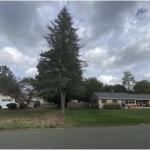 Perhaps despite perception in some circumstances, ownership of a tree is generally not determined by the reach of a tree's branches or the extent of its roots; rather, ownership is determined at the location where the main trunk rises from the soil. This is referred to as the base of the trunk rule and with this in mind, ownership is assumed to include all of the limbs, branches, and roots associated with the tree. Even in a scenario where the majority of a tree’s above-ground biomass overhangs a neighboring property, ownership of the tree is ascribed to the proprietor of the land from which the base of the trunk arises. If the base of the trunk is not entirely located on one side of a property line, ownership of the tree is shared among the landowners. Thus, the relevant parties co-own or share in the duty of reasonable inspection, maintenance, and if warranted, removal of the tree.
Perhaps despite perception in some circumstances, ownership of a tree is generally not determined by the reach of a tree's branches or the extent of its roots; rather, ownership is determined at the location where the main trunk rises from the soil. This is referred to as the base of the trunk rule and with this in mind, ownership is assumed to include all of the limbs, branches, and roots associated with the tree. Even in a scenario where the majority of a tree’s above-ground biomass overhangs a neighboring property, ownership of the tree is ascribed to the proprietor of the land from which the base of the trunk arises. If the base of the trunk is not entirely located on one side of a property line, ownership of the tree is shared among the landowners. Thus, the relevant parties co-own or share in the duty of reasonable inspection, maintenance, and if warranted, removal of the tree.
Trespass
A trespass is referred to as the unlawful entry onto the land of another and at its essence, it is typically a physical invasion. Since a property owner can generally establish as many trees as they want on their own land, there may be the temptation on behalf of a neighbor to want to prune or even remove trees they consider unsightly or that interfere with a function on their own property, such as the blocking of light for a garden or solar panel array. Or they may want to simply inspect the neighboring trees for undue risk. Crossing onto another's property line without expressed consent of a property owner is simply not permitted. Trespass violations may also be in the form of “drift” from a negligent pesticide application that crosses onto the property of another and causes undue harm to trees and shrubs. In many states, damages associated with a trespass to another’s property may be required to be repaid in orders of increasing magnitude (2x - 3x), and one may be convicted of a trespass even if the act was not willful. Other repercussions associated with trespass may include fines and even imprisonment.
“Acts OF GOD” and Liability
A naturally-occurring extreme weather event that causes the failure of a tree branch or entire tree, may be referred to as an “act of God’’. These scenarios may include a period of abnormally high wind, or perhaps a snow, ice, or lightning storm.
In this circumstance, the court may attempt to examine the condition of the tree prior to the event to determine if it was being reasonably maintained and periodically inspected. Thus, if the tree was presumed to be in a reasonably healthy condition and it was concluded that the storm event was the catalyst for branch or tree failure that caused undue damage to property or life, it may be concluded that no liability exists. If it was determined that the tree featured a structural defect that would have been revealed by an inspection, it is possible that the court may rule that that the owner should have removed the tree or pruned the branches as part of a reasonable care regime, and the tree owner may be held liable for damages. It is important to keep in mind that this burden of proof is often extremely difficult to meet. When liability has been found, damages must then be determined - these usually fall into the following four categories:
- Compensatory - Covering the actual loss of trees and other injuries.
- Statutory - Extra damages the individual held liable is required to pay by statute.
- Punitive - Damages awarded when the individual held liable is determined to have acted maliciously.
- Actual - Damages awarded in relation to actual and real losses that have occurred.
Variation in Laws
In the same way that local ordinances can vary from community to community, laws governing trees and their care vary from state to state. The self-help theory that is promulgated in the “Massachusetts Rule” is prevalent throughout many states, however, the restatement rule (also known as the “Hawaii Rule”) may make provisions in some states for aggrieved individuals to make demands of adjoining landowners. For example, in some states, if a branch from a tree is interfering with the enjoyment of the neighbor’s property, though they may not own the tree, the aggrieved neighbor may demand that the individual who owns the tree take action (i.e. have it pruned). If the owner of the tree elects to not take action, the aggrieved neighbor may proceed to have the tree pruned themselves and send the owner the bill.
Principles for the Professional
Though variation exists at both the community level, as well as from state to state, practicing arborists and urban foresters can apply some important concepts when it comes to prudent arboricultural practices and the law:
1) Confirm property boundaries and ownership of trees
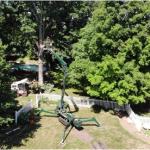 Since complaints relating to trespass are commonplace, and resulting legal actions may ensue, arborists should always confirm the boundaries of a client’s property and the ownership of a tree in question. Even if a client claims their word is factual, it is up to the arborist as the professional to conduct due diligence and fact-check. In most states, public domain records can be accessed free of charge to help determine property lines, and in many municipalities GIS maps may be accessed online and prove to be of further help. In the event that questions about boundary lines remain, request that the client have their property surveyed before conducting any work. In the instance that the tree in question is a roadside tree, confirm with the municipal forester or tree warden if it is in fact a municipally-owned tree.
Since complaints relating to trespass are commonplace, and resulting legal actions may ensue, arborists should always confirm the boundaries of a client’s property and the ownership of a tree in question. Even if a client claims their word is factual, it is up to the arborist as the professional to conduct due diligence and fact-check. In most states, public domain records can be accessed free of charge to help determine property lines, and in many municipalities GIS maps may be accessed online and prove to be of further help. In the event that questions about boundary lines remain, request that the client have their property surveyed before conducting any work. In the instance that the tree in question is a roadside tree, confirm with the municipal forester or tree warden if it is in fact a municipally-owned tree.
2) Engage in clear communication
Upfront, forthright communication between neighbors, and between professional arborists and their clients may save many future hours of court-related aggravation and expense. Even if the branches, roots, or other parts of a tree encroach onto a neighboring property, asking the owner for permission and clearly explaining the situation and the proposed remediation may help build good will and foster cooperation. Arborists that take the time to explain the legal implications associated with trespass and the legal limitations associated with the care of another individual’s tree may prevent future court action. These opportunities for interaction can also foster social cohesion among community members and even provide the opportunity for clients to agree to regular inspection of their trees.
3) Keep records
Under most circumstances a court of law will only recognize written documentation. So concerned residents and professional arborists should be sure to keep a written record of requests, discussions, contracts, inspections and work-orders that are ideally signed and dated. If a tree of concern is identified, make sure that it is put in writing and utilize standard industry terminology that also includes professional recommendations. Documenting information including crew members on site, a description of the job, date, time and pertinent activities may be important in the event that legal action is taken. Signed contracts and documentation of access agreements is vital to avoiding legal penalties. Remember, if it is not in writing, it probably won't be recognized in court.
Courts recognize trees as real property and they can be a significant asset to any landowner providing shade, clean air, carbon sequestration and intercepting rainwater. To another individual, however, they may impede a view, block light, or drop unwanted leaves and fruit. Good stewardship of our trees may not just be limited to following sound arboricultural practices that include proper pruning or routine risk inspections; it also includes educating ourselves about our rights and responsibilities as property owners and professional arborists.
Chadd W. Morin, graduate of Urban Forestry/Arboriculture program, University of Massachusetts Amherst, and Richard W. Harper, PhD, Extension Associate Professor of Urban and Community Forestry, University of Massachusetts Amherst
Trouble Maker of the Month
Lesser celandine, Ranunculus ficaria
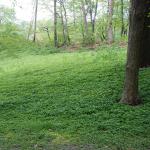
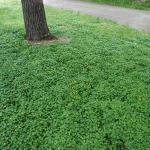 Species overview
Species overview
Lesser celandine, also known as fig buttercup and fig-crowfoot, is a member of the buttercup family, Ranunculaceae. Ranunculus verna is a botanical synonym for Ranunculus ficaria. Lesser celandine is an herbaceous perennial and a spring ephemeral. As a spring ephemeral, it is vegetatively present from early spring to early summer. Native to Europe, lesser celandine was first introduced into the United States as an ornamental, but is commonly considered to be invasive because of its vigorous growth habit that creates dense mats that outcompete native spring, forest, spring ephemeral wildflowers including spring beauties, trilliums, bloodroot, and wild ginger. These native wildflowers are a source of nectar for bees and other insects in the early spring. The bare ground left behind after lesser celandine senesces in late spring may then be colonized by other weedy species or invasives.
Habitat
Prefers moist soil and thrives along stream and riverbanks, in forested flood plains, and in wetlands. Will grow in drier habitats as well and can often become of weed in turf and landscape areas.
Identification characteristics
- Growth habit - Leaf rosettes form a dense mat that excludes other herbaceous vegetation.
- Leaves - The glossy, kidney- to heart-shaped leaves measure between 0.5 to 1.5 inches in length and are dark green in color. Leaf margins are entire but may have scalloped or toothed edges. Leaf surface is smooth with prominent veins and sometimes have a variegated appearance. Some sub-species produce pale aerial bulbils in the leaf axils.
- Flowers - Bright, buttery yellow with 8 oval petals (sometimes up to 12), about an inch in diameter are borne singly on slender stalks that rise above the leaves. Flowers appear between March and May.
- Roots - Fibrous root system with numerous finger-like tubers that are easily visible when plants are uprooted.
- Reproduction - Vegetatively propagated asexually by tubers and aerial bulbils and sexually by seed.

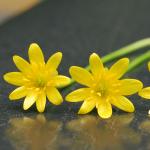
Management
- Non-chemical - Small infestations of lesser celandine can be dug out using a hand trowel or small shovel. Effective removal of the plants from a site requires the removal of all plant parts including underground tubers. Tubers are small and may be overlooked in the soil, so return visits should be made over the next couple of years to locate and remove remaining plants. Plants that are removed should be left to dry out on a hard surface or on a tarp to die. Small areas can be smothered with a cover; this will require that the cover to be in place for a period of years.
- Turf - Broadleaf turf herbicide combination products that contain MCPA, fluroxypyr, triclopyr, and/or dicamba are the most effective. Application should be done in the spring when leaves are green as long as the temperature is at least 50 degrees F, and no rain is anticipated within 18 hours. Bare turf area can be seeded in late summer and early fall.
- Landscape - Directed-spray glyphosate applications should be made early in the season between mid-March and early April as long as the temperature is at least 50 degrees F and no rain is anticipated within 18 hours.
Randy Prostak, UMass Extension Weed Specialist
Q&A
Q. There seems to be so much emphasis on soil pH… how exactly does soil pH work and why is it so important for my gardens and landscape?
A. Soil pH is a measure of acidity, quantified by the number of free hydrogen ions (electrically charged atoms, denoted by H+ in this case) present in the soil “solution” (the liquid fraction of the soil in which nutrients and other compounds are dissolved). It’s a bit counterintuitive, but a lower pH value indicates higher acidity (more hydrogen ions in the soil solution). pH values below 7.0 are in the acidic realm, 7.0 is considered neutral, and above 7.0 is alkaline, or basic (less hydrogen ions in the soil solution). Most soils in New England naturally trend towards the acid side and a typical pH value for un-limed northeastern soils is around 5.0, indicating a significant degree of acidity.
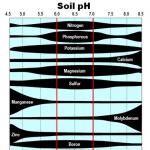 A common misconception is that soil acidity is a tangible, harmful agent that negatively impacts plants in a direct sense. This is not nearly as consequential, however, relative to possible indirect effects; interconnected effects that have implications for the entire plant/soil system. For example, maintaining pH in a favorable range is central to effective nutrient management, as pH is one of the most significant drivers of soil nutrient availability (Fig. 1).
A common misconception is that soil acidity is a tangible, harmful agent that negatively impacts plants in a direct sense. This is not nearly as consequential, however, relative to possible indirect effects; interconnected effects that have implications for the entire plant/soil system. For example, maintaining pH in a favorable range is central to effective nutrient management, as pH is one of the most significant drivers of soil nutrient availability (Fig. 1).
As shown in the figure, the primary nutrients nitrogen, phosphorus, and potassium are most available within the so-called “neutral range” of 6.0 to 7.0, as are the important secondary nutrients magnesium and sulfur. Essential micronutrients such as boron and copper are also readily available when the soil is in a slightly acidic state. In many cases, good pH management is all that is needed to promote sufficient micronutrient availability. These are some of the main reasons why, generally speaking, that many agricultural and horticultural soils have a target pH of around neutral to slightly acidic.
When pH is skewed, however, plants can suffer from nutrient deficiencies and associated problems with growth, appearance, and function. On the other end of the spectrum, availability of elements like aluminum can become excessive and reach plant-toxic levels when the soil becomes too acidic. Moreover, numbers and activity of soil microorganisms can be reduced when pH is too high or too low, further affecting nutrient release from organic decomposition and other meaningful, positive contributions from those populations.
The natural tendency of our soils for lower pH is most easily managed by regular liming. Applications of calcitic (calcium carbonate) or dolomitic (calcium magnesium carbonate) limestone create a reaction that removes hydrogen ions from the soil solution, thereby raising pH over time. Liming materials also supply essential calcium, which can be less available even at favorable pH levels. The best guide for how much lime and how often? Soil testing. Soil testing to inform liming needs is affordable and freely available from multiple labs, including the UMass Soil & Plant Tissue Testing Lab. For more information on adjusting soil pH from the UMass Lab, go to: https://ag.umass.edu/soil-plant-nutrient-testing-laboratory/fact-sheets/adjusting-soil-ph
An important note for the landscape is that not all plants perform best at a pH level in the neutral range. So-called acid loving plants include blueberries, hollies, azaleas, rhododendrons, dogwoods and many conifers. Again, it comes down to nutrient availability – most of these plants perform best with higher levels of the micronutrients (often iron) most available at lower (acidic) pH levels. Acidifying fertilizers such as ammonium sulfate are commonly used to maintain a lower soil pH and enhance the quality of these unique species.
Q. I have a large yet well-defined area of my Massachusetts lawn that is problematic every year. The turf itself is impressive… dense and uniform. However, while it is brilliant green in June, July, and August, the green quickly fades to brown with cooler weather, to the point where it even appears “bleached” in the winter and early spring. What is going on with this area?
A. Whenever we hear a description like the above, exceedingly often the main grass involved is Zoysiagrass (Zoysia japonica). Zoysia happens to be a warm-season (C4) grass, which means that the temperatures most favorable for its growth are in the range of approximately 80o-95o F. A special aspect of Zoysia is that it is one of very few warm-season grasses that has the capacity to persist through Northeastern winters.
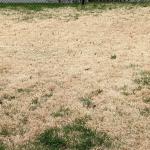 Because of its numerous positive attributes including high density, recovery from injury, and resistance to weed and pest infestation, Zoysia was touted as a ‘miracle grass’ in national marketing campaigns years ago, hence its frequency in appearing in the landscape. Nothing is perfect, of course, and a tradeoff is that this grass is green for only about 3 months of the year under Massachusetts conditions, while appearing brown or “bleached” for the other 9 months or so.
Because of its numerous positive attributes including high density, recovery from injury, and resistance to weed and pest infestation, Zoysia was touted as a ‘miracle grass’ in national marketing campaigns years ago, hence its frequency in appearing in the landscape. Nothing is perfect, of course, and a tradeoff is that this grass is green for only about 3 months of the year under Massachusetts conditions, while appearing brown or “bleached” for the other 9 months or so.
Zoysia also has significant spreading capacity, and areas will typically increase in size year over year. While this can be beneficial from a strictly turf-forming perspective, stolons frequently run into driveways and walks and landscape beds, which can create an additional maintenance burden in terms of edging to keep things under control. Physical edging materials (plastic, metal, stone, etc) can also often do a good job of keeping Zoysia ‘in-bounds’.
For those that can deal with the drawbacks, Zoysia commonly makes up a very functional and resilient lawn. Where there is a desire to control Zoysia, there are materials that will do a fair job of suppressing it selectively, but the approaches are complex and labor intensive and most of the materials are available only to licensed professionals. Even if selective approaches are successful, patches of Zoysia are often so large and dense that the result is virtually the same as using a non-selective material, such as glyphosate, for a complete renovation. The non-selective route is often the most straightforward approach, followed by reseeding with more desirable grasses (at the ideal planting time, which is late summer). Even then, it may take two applications at the highest labeled rate to achieve eradication. It also often helps to skip a mowing before application, to increase leaf area for better herbicide contact.
Jason Lanier, UMass Extension Turf Specialist
Garden Clippings Tips of the Month
May is the month to . . . .
-
Watch for ticks! Ticks are active and it is important to protect yourself with a repellent when working outdoors and to check yourself every day after working outdoors. If you find a tick imbedded on yourself or on your pet, send the tick to a tick testing laboratory for identification and testing for tick borne pathogens. There are many commercial laboratories that can provide testing of ticks for common pathogens. For a listing of some of these tick testing laboratories, go to: https://ag.umass.edu/resources/tick-testing-resources
-
Plant trees and shrubs. Spring is a good time of year to plant trees and shrubs because this gives roots time to grow into the surrounding soil before stress from high summer temperatures occurs. During the spring, there is usually adequate moisture in the soil from spring rains to enable plants to grow and establish without moisture stress. When planting trees and shrubs, the planting hole should be as deep as the plant was in the container and 2-3 times as wide. It is important to cut any circling roots before planting to encourage outward root growth. When backfilling the planting hole, fill the hole half way with soil and water it in, then fill the hole the rest of the way and water thoroughly again to ensure that the soil settles well and is not compacted.
-
Mulch around newly planted trees and shrubs. Organic mulches provide many benefits to newly planted trees and shrubs and other landscape plantings. The benefits of mulch include moisture retention, control of fluctuations in soil temperature, weed suppression, and prevents tree and shrub damage from lawn mowers. Organic mulches also look attractive and help with the addition of organic matter in the soil through decomposition. Make sure you remove established perennial weeds before mulch is applied. Avoid mulch depths greater than 4 inches and do not allow mulch to contact the base of trees and shrubs.
-
Prune spring flowering shrubs. Spring flowering shrubs form their flower buds the previous year on last season’s stem growth. Pruning these shrubs before bloom removes flower buds and reduces the number of flowers. These shrubs such as forsythia (Forsythia spp.), rhododendrons and azaleas (Rhododendron spp.), Virginia sweetspire (Itea virginica), mock orange (Philadelphus spp.), ninebark (Physocarpus opulifolius), spring blooming spirea (Spirea prunifolia and S. vanhouttei), lilacs (Syringa spp.) and viburnums (Viburnum spp) should be pruned after bloom for maximum flower display. When pruning deciduous shrubs, follow the principle of thinning and renewal by removing 1/3 of the existing stems each year, chooing the oldest stems each time. Well pruned shrubs should contain stems of various ages.
-
Transplant cool season crops. Cool season crops such as brassicas, onions, leeks, and spinach can be transplanted into the garden after hardening them off. Move the transplants outside to harden them off once daytime temperatures are consistently above 45oF. Transplants grown either indoors or in a greenhouse need a transition period to adjust to outdoor conditions before being planted in the field. If transplants are planted directly in the garden before they are adjusted to sun, wind, rain and cool outdoor temperatures, they may not survive the shock. Transplants should gradually be exposed to outdoor conditions so that they can slowly adjust to harsher outdoor conditions. When transplants are sufficiently hardened-off and they can stay outside the whole day, plant them in the garden. Choose a cloudy day to plant if possible. Make sure plants are watered thoroughly after planting and water them in with a dilute starter fertilizer solution.
-
Direct sow seeds of summer vegetables. Some summer vegetables such as beans, corn, cantaloupes, okra, zucchini, watermelon, cucumber, squash and pumpkin can be directly sown in the field at the end of May when there is no risk of frost. Soil temperatures should have warmed adequately for seeds to germinate and seedlings to grow well. Use a soil thermometer to check soil temperature. Soil thermometers can be purchased inexpensively from garden centers, garden supply catalogs, or online retailers. Garden soil temperatures should be 60⁰F or higher.
-
Start weeding. Weeds are easier to remove when they are young and shallow-rooted. Take time to remove weeds in the garden and landscape before they start competing for nutrients and water with your plants. If weeds are not removed early, weed infestation can become overwhelming. Removing weeds early also prevents them from going to seed, which will reduce weed infestations in future seasons. When removing perennial weeds, make sure to remove all of the underground portions of the plant to prevent the plant from sprouting again.
-
Fertilize lawns. Apply 3/4 to 1 pound nitrogen per 1,000 square feet using a product that contains 50% or more of the nitrogen in a slow-release form. Try to schedule the application prior to rain or irrigate following application to move the fertilizer off the leaf blades. Fertilizers should not contain phosphorus unless a soil test recommends that phosphorus is needed or if it is being applied in conjunction with seeding or over-seeding. For information on how to get a soil test, go to: soiltest.umass.edu.
-
Visit your local garden center. The month of May is the busiest month for garden centers and retail greenhouse operations when they have a wide selection of plants and vegetable transplants available. By purchasing plants from your local garden center this month, you will get the best selection of plants and service, and you will feel good about supporting local businesses.
Geoffrey Njue, UMass Extension Sustainable Landscapes Specialist
Are the Bees Still Dying? An Update on Bee Health
This is an abbreviated version of the original article. Full article in UMass Extension's Vegetable Notes along with links to more resources and further reading.
As a pollinator specialist, I’m often asked “are the bees still dying?” The answer to that question is a complicated “yes”, but the outlook is ultimately hopeful. Here is what we’ve learned about bee health over the past few decades.
1. IT BEGINS: COLONY COLLAPSE DISORDER
You may remember when “bee-pocalypse” first hit the news. It was 2006, and beekeepers reported bees abandoning hives en masse. Researchers flocked to investigate, and the syndrome was dubbed Colony Collapse Disorder (CCD). It is important to point out that the name “Colony Collapse Disorder” is misleading. It sounds like a generic term for “bee declines”, but it is not. It refers to a specific syndrome that was observed in US honey bee colonies around 2006-2009, in which worker bees abandon an otherwise healthy-seeming colony, leaving the queen and developing larvae to die. Honey bee colonies can die in many other ways, including starvation, parasites, gut pathogens, pesticide-poisoning, and queen failure. In general, these colonies die over the winter when they run out of food or are overwhelmed by pathogens. CCD cases were notable because there were no dead bees in the hive; they had simply vanished.
However, new surveys show that honey bee deaths continued to remain high for reasons unrelated to CCD. Historically, beekeepers expected to lose 10-15% of their colonies each winter. In 2010 and subsequent years, beekeepers in many states reported that they lost nearly 50% of their colonies on average. Few of those dead colonies exhibited CCD-like symptoms; most died from numerous commonplace causes like parasites or starvation. For some reason, colonies were just dying at higher rates than they had in the past. CCD turned out to be a small problem, but it had exposed a much bigger one.
2. A MUCH BIGGER PROBLEM
The western honey bee (Apis mellifera) is native to Europe, the Middle East and Africa, and the vast majority of honey bee colonies are managed by beekeepers. When colonies die, beekeepers can replace them by dividing their remaining hives. For this reason, it is not meaningful to talk about honey bee population declines, because the number of honey bee colonies in the world depends on economics and management choices, not biology. Instead, a more accurate measure of honey bee health is “percent yearly loss”, or the portion of a beekeeper’s hives that die each winter.
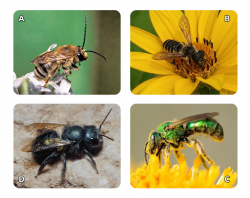 As scientists continued to study bee health, they realized that honey bee hive losses were only half of the story. There are over 20,000 other bee species around the world whose populations were not tracked or well-understood. In North America, there are over 4,000 native bee species (more than 400 native to New England alone!) including long-horned bees, leafcutter bees, sweat bees, and blue orchard bees. Most of these native bees are wild – only a few are managed commercially, like the common eastern bumble bee. They feed on nectar and pollen, but do not produce honey. Most are solitary, and nest in the ground or in pithy stems. To complete their lifecycle, they require undisturbed habitat and nearby flowering resources. It is difficult to document native bee populations, but studies have found that the number of species has declined significantly over the past century, especially since the 1990s.
As scientists continued to study bee health, they realized that honey bee hive losses were only half of the story. There are over 20,000 other bee species around the world whose populations were not tracked or well-understood. In North America, there are over 4,000 native bee species (more than 400 native to New England alone!) including long-horned bees, leafcutter bees, sweat bees, and blue orchard bees. Most of these native bees are wild – only a few are managed commercially, like the common eastern bumble bee. They feed on nectar and pollen, but do not produce honey. Most are solitary, and nest in the ground or in pithy stems. To complete their lifecycle, they require undisturbed habitat and nearby flowering resources. It is difficult to document native bee populations, but studies have found that the number of species has declined significantly over the past century, especially since the 1990s.
Native bees are also critical for crop pollination. Until the second half of the 20th century, farmers relied almost exclusively on resident wild bees for “free” pollination. It was only when field sizes increased and field edges (which had previously provided habitat) were converted into row crops that many farms could no longer support robust native bee populations, and farmers began to rent honey bee colonies. Today, the demand for pollination services is so high that commercial beekeepers make most of their income through pollination services, not honey.
 However, new research shows that native bees continue to provide critical pollination services to crops. A recent national study found that native bees comprise a significant portion of crop flower visits and provide the majority of pollination services for certain crops, like pumpkins. Many native bee species are actually more efficient pollinators than honey bees, especially for crops that are native to the Americas like tomato, cranberry, blueberry, and pumpkin. Farms with small field sizes and unmanaged areas can often be fully pollinated by resident native bees.
However, new research shows that native bees continue to provide critical pollination services to crops. A recent national study found that native bees comprise a significant portion of crop flower visits and provide the majority of pollination services for certain crops, like pumpkins. Many native bee species are actually more efficient pollinators than honey bees, especially for crops that are native to the Americas like tomato, cranberry, blueberry, and pumpkin. Farms with small field sizes and unmanaged areas can often be fully pollinated by resident native bees.
3. WHY ARE NATIVE BEES IN DECLINE, AND HONEY BEE HIVES DYING?
After years of research, scientists have identified a slew of interacting factors that trace back decades. The big three are habitat loss, novel pathogens, and pesticide exposure, but other factors include climate change, invasive species, and bee management practices. Here is a summary of how these factors affect native bees and honey bees.
Habitat Loss
Reduced abundance and diversity of floral resources and destruction of undisturbed nesting locations is consistently identified as the most important driver of native bee declines. Reduced floral diversity results in poor nutrition for native bees and exacerbates the impacts of disease and pesticide poisoning. This problem is nearly a century in the making. Beginning after World War II, many farmers began to use synthetic fertilizers in place of flowering cover crops like alfalfa and clover. They also began to use more effective herbicides, leading to fewer flowering weeds within and around crop fields. The expansion of cities and suburbs also destroyed or fragmented bee habitat. By the early 2000s, there was less nesting habitat and fewer floral resources for bees, especially in agricultural areas.
Pathogens
New pathogens are a problem for all bees, but are especially important for understanding honey bee losses. Like humans, bees can become infected with bacteria, viruses, and parasites. This is a perennial challenge (there are reports of honey bee disease from the 19th century), but in the late 1980s, a new honey bee parasite arrived in the United States that was particularly damaging and continues to devastate the beekeeping industry: the Varroa mite.
It is hard to overstate Varroa’s impact on honey bee health. Mites feed on honey bees’ organs, weakening their immune system and reducing their ability to detoxify pollutants like pesticides. They also transmit over a dozen damaging viruses and will kill a colony within a year or two if left untreated. Experts are working to breed Varroa-resistant bees, discover better management practices, and develop more effective acaracides, but the work is slow. Luckily, Varroa do not parasitize other bee species. However, wild bees face their own pathogens, like the gut parasites Nosema and Crithidia. While they are not as devastating as Varroa mites, they do weaken bees and reduce their ability to withstand other health challenges like poor nutrition.
Pesticides
Agrochemicals – especially insecticides – are important for controlling crop pests and producing enough food for people, but can also harm bees. Balancing pest-control needs with non-target impacts is a perennial challenge for farmers. However, the issue became super-charged a few decades ago around a new class of pesticides called neonicotinoids.
Neonicotinoids were developed in the 1980s and began to be used broadly in the early 1990s. Today, they are the most widely used class of insecticide in the world and imidacloprid is the most commonly used agrochemical after glyphosate. They are less toxic to vertebrates than other insecticides (so are much safer for growers), they can be used at very low doses, and they don’t have to be sprayed so are less likely to drift onto non-target plants. However, they are also highly toxic to bees, causing direct mortality and sublethal effects. Bees encounter neonicotinoids in nectar and pollen, as well as in runoff in nearby soil and water, and in the “dust” that flakes off treated seeds during planting. In honey bees and bumble bees, neonicotinoids have been shown to impair navigation, learning, and memory, and to curtail colony growth. It is hard to study their impact on solitary wild bees, but effects are expected to be similar or worse, given the bees’ smaller body size.
It is also important to note that neonicotinoids are not the only pesticides that harm pollinators. For example, fipronil, an insecticide widely used by homeowners to control ants and termites, is highly toxic to bees, as are other vegetable pesticides like pyrethroids (e.g. WarriorTM) and carbamates (e.g. LannateTM). In addition, some fungicides, such as chlorothalonil (e.g. BravoTM), have recently been correlated with an increased risk of gut disease in honey bees.
Climate change
Climate change is expected to negatively impact native bees. It could lead to phenological mismatches between bee and plant lifecycles and result in range shifts which are not consistent between pollinators and their associated plants. Further, extreme weather events could destroy bee nests or interfere with foraging.
Other factors
There are several other factors that impact bee health. For honey bees, this includes poor genetic diversity in the US as well as migratory beekeeping practices that stress bees and circulate disease. For native bees, it includes invasive plants, which crowd out native plants and interrupt local plant-pollinator relationships, as well as honey bees themselves, which may compete with native bees for resources and spread disease.
Finally, it is important to note that these stressors compound one another. For example, bees that are parasitized with Varroa are more susceptible to poisoning by pesticides, exposure to neonicotinoids leaves honey bees more susceptible to the gut pathogen Nosema, and bees’ ability to survive infection is reduced by nutritional stress.
4. WHAT CAN WE DO?
Bees are declining for complex reasons, but it turns out that helping bees is relatively straightforward: it’s all about improving habitat.
There are two main ways that growers (and others) can help bees:
- Increase foraging resources and nesting habitat (and/or protect habitat that already exists). In other words, plant bee-friendly flowers and leave marginal areas undisturbed. Growers can provide flowering resources by planting flowering cover crops like buckwheat and phacelia or intercropping with low-growing flowering plants like clover, add flowering resources and create nesting habitat by planting perennial flower strips on field margins or establishing undisturbed meadows (see Figure 2).
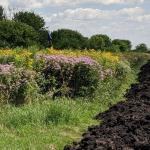 Another way to increase pollinator habitat at scale is to plant bee habitat on public land. In Massachusetts, there is currently an effort by the Department of Transportation to establish bee habitat on publicly owned land like roadsides and around municipal buildings.
Another way to increase pollinator habitat at scale is to plant bee habitat on public land. In Massachusetts, there is currently an effort by the Department of Transportation to establish bee habitat on publicly owned land like roadsides and around municipal buildings. - Practice bee-friendly pesticide use. This means using integrated pest management principles whenever possible: use actual pest levels (through observation or scouting reports) to determine when and what to spray and rotate active ingredients. It also means avoiding spraying bee-attractive crops during bloom and choosing pesticides that are less toxic to bees. You can read more about bee-friendly pesticide practices here.
BEE HEALTH TAKE-AWAYS
- The term Colony Collapse Disorder (CCD) is misleading. It does not refer to general bee declines. It refers to a specific syndrome that affected US honey bee colonies from about 2006-2009.
- However, CCD was important because it turned researchers’ attention to bee health at a moment when several decades-long trends were hurting both managed and unmanaged bees. Today, yearly honey bee losses are still elevated, and we are only just beginning to understand the scope of native bee declines.
- In the past, native bees provided all pollination services on farms; only after farm sizes increased in the mid-20th century were honey bees used for large-scale pollination.
- We are learning that native bees still provide significant pollination services to crops and their numbers can be boosted by establishing nearby habitat.
- The biggest drivers of bee stress are habitat loss (especially loss of food and nest sites for native bees), pathogens (especially Varroa mites for honey bees) and pesticide exposure, as well as climate change, invasive species, and beekeeping practices.
- The best way to support bees is to increase pollinator habitat (flowering resources and undisturbed areas) on farms, and to use pollinator-friendly pest management practices.
- Massachusetts growers are already supporting bees! More than 80% of recently surveyed MA commercial growers maintain some form of pollinator habitat on their land.
Hannah Whitehead, UMass Extension Vegetable Program
Upcoming Events
For more details and registration options for any of these events, go to the UMass Extension Landscape, Nursery, and Urban Forestry Program Upcoming Events Page.
- May 24, 2022 - Landscape Pests and Problems Walkabout: Diseases and Weeds, 4:00-6:00 pm. Location: Arnold Arboretum, Jamaica Plain MA. Two pesticide contact hours in categories 36 and Applicator's License. Association credits: 1 MCH, 1 MCA, and 1 MCLP.
Pesticide Exam Preparation and Recertification Courses
These workshops are currently being offered online. Contact Natalia Clifton at nclifton@umass.edu or go to https://www.umass.edu/pested for more info.
InsectXaminer!
Episodes so far featuring gypsy moth, lily leaf beetle, euonymus caterpillar, imported willow leaf beetle, and spotted lanternfly can be found at: https://ag.umass.edu/landscape/education-events/insectxaminer
TickTalk with TickReport Webinars
To view recordings of past webinars in this series, go to: https://ag.umass.edu/landscape/education-events/ticktalk-with-tickreport-webinars
Additional Resources
For detailed reports on growing conditions and pest activity – Check out the Landscape Message
For professional turf managers - Check out our Turf Management Updates
For commercial growers of greenhouse crops and flowers - Check out the New England Greenhouse Update website
For home gardeners and garden retailers - Check out our home lawn and garden resources.
Diagnostic Services
Landscape and Turf Problem Diagnostics - The UMass Plant Diagnostic Lab is accepting plant disease, insect pest and invasive plant/weed samples . By mail is preferred, but clients who would like to hand-deliver samples may do so by leaving them in the bin marked "Diagnostic Lab Samples" near the back door of French Hall. The lab serves commercial landscape contractors, turf managers, arborists, nurseries and other green industry professionals. It provides woody plant and turf disease analysis, woody plant and turf insect identification, turfgrass identification, weed identification, and offers a report of pest management strategies that are research based, economically sound and environmentally appropriate for the situation. Accurate diagnosis for a turf or landscape problem can often eliminate or reduce the need for pesticide use. See our website for instructions on sample submission and for a sample submission form at https://ag.umass.edu/services/plant-diagnostics-laboratory. Mail delivery services and staffing have been altered due to the pandemic, so please allow for some additional time for samples to arrive at the lab and undergo the diagnostic process.
Soil and Plant Nutrient Testing - The lab is accepting orders for Routine Soil Analysis (including optional Organic Matter, Soluble Salts, and Nitrate testing), Particle Size Analysis, Pre-Sidedress Nitrate (PSNT), and Soilless Media (no other types of soil analyses available at this time). Testing services are available to all. The lab provides test results and recommendations that lead to the wise and economical use of soils and soil amendments. For updates and order forms, visit the UMass Soil and Plant Nutrient Testing Laboratory web site.
Tick Testing - The UMass Center for Agriculture, Food, and the Environment provides a list of potential tick identification and testing options at: https://ag.umass.edu/resources/tick-testing-resources.